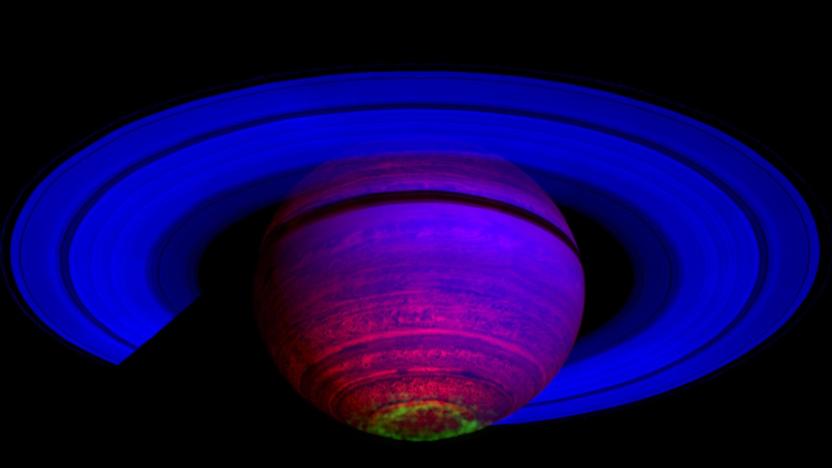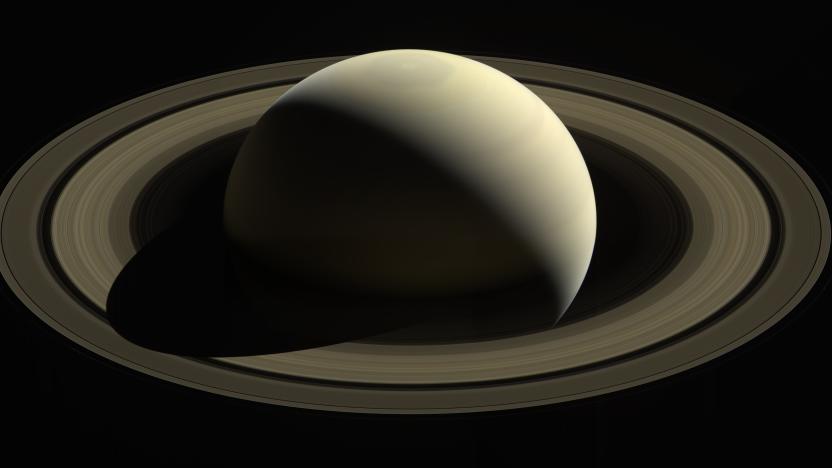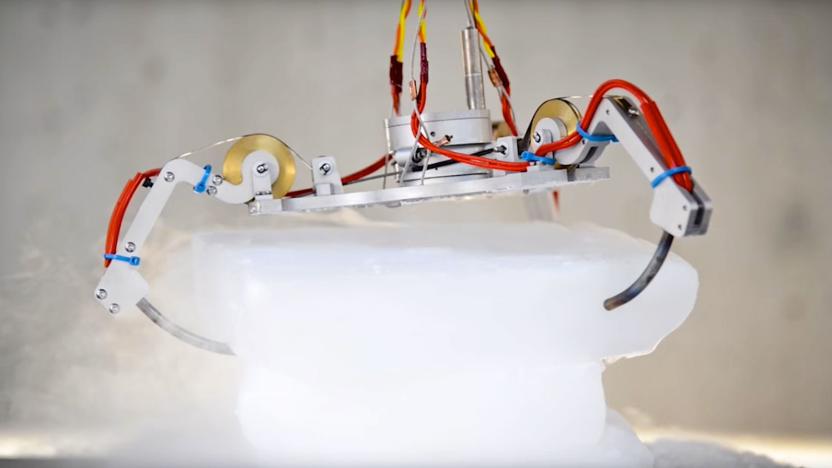Enceladus
Latest

How NASA will defend the Earth against plagues from outer space
In the summer of 1957, the Earth stood witness as a meteorite cratered in rural Pennsylvania, bringing with it a people-eating plague never seen: an alien amoeba with the taste for human flesh. While we had Steve McQueen around for the first invasion, humanity is now defended against microbial marauders from outer space by NASA and its international counterparts.

What's next for NASA as Cassini's mission comes to a close
After nearly two decades in space and 11 years studying Saturn (and its myriad moons), the Cassini spacecraft ended its mission at roughly 6:30 am Eastern on Friday when it slammed into the gas giant's suffocating atmosphere. It was an auspicious end for the $3.4 billion spacecraft, argues Curt Niebur, the program scientist for Cassini at NASA headquarters. "I find it exhilarating, myself," he said. "Instead of just crashing it into something and saying we're done, we're actually going after science questions that we never intended Cassini to answer. And we'll be able to address those. It's fantastic."

Nine of Cassini’s most exciting discoveries about Saturn
Saturn is something of a solar system unto itself (minus the requisite sun). It's surrounded by 53 confirmed moons and another 9 "moonlets," tiny worlds that are among the most exotic and diverse we've seen in this neck of the galaxy. For as much as we could see from our Earth-based telescopes, it was only by getting up close and personal with the system's second largest planet -- by sending a $3.4 billion science machine hurtling 8.88 million miles across interplanetary space -- that we were able to truly observe Saturn. And it's a good thing we did because the scientific discoveries have been near-constant in the 11 years since Cassini left home. We've seen the surface of Titan and watched its liquid methane flow, fall like rain into massive hydrocarbon seas. We saw the tiny icy moon of Enceladus reveal its 101 geysers which shoot hundreds of pounds of water ice and molecular hydrogen into space from a subsurface ocean. Think of the life we'll find in there! And above all, the Cassini mission helped us better understand the atmosphere and global mechanisms of Saturn itself. Here are nine of the most exciting scientific discoveries the Cassini mission brought about.

Saturn and Jupiter's moon burps bode well for distant life
Scientists recently took a closer look at data over a decade old and concluded that two moons orbiting Saturn and Jupiter might have environments that foster life. During an October 2015 flyby of the ringed planet's moon Enceladus, the probe Cassini was hit by gaseous plume, which was likely a hydrothermal vent breaking through the iced surface. Scientists theorize that the spray is evidence of chemical energy for life to feed on. Thanks to sporadic evidence of plumes on Jupiter's moon Europa, NASA has announced that two locations in the solar system might support living organisms.

How NASA's future robots will explore frozen worlds
Delivering a rover to the surface of a distant icy world like Jupiter's moons Europa and Titan is only half the challenge. Once on the surface, the robotic explorers will have to contend with intense space radiation, plunging temperatures that drop to hundreds of degrees below zero and miles upon miles of ice before hitting the subsurface oceans that astronomers suggest may contain life. But NASA has a plan.

Cassini leaves Saturn's moon Enceladus after one last mission
The Cassini vehicle has been visiting Saturn's moon Enceladus for a full decade now, but it's finally time for the two to bid adieu. The spacecraft will fly by Enceladus for the last time at 12:49PM on Saturday, skimming a "moderately close" 3,106 miles above the surface. It won't just be reminiscing on its way out, though: its last major Enceladus mission will see it mapping the icy moon's internal heat, taking advantage of Saturn's years-long winter to conduct studies in ideal conditions.

Cassini gets cozy with Saturn's moon, flies 30 miles above its surface
Cassini has just finished the second of three planned Enceladus flybys on October 28th, going as close at 30 miles above the surface of the icy moon's south polar region. The photo above was taken after the flyby, showing both the moon and Saturn's rings, but rest assured the probe took a lot of close-up photos. It even grabbed some of the gas and dust that erupted from one of Enceladus' geysers that typically spew water and other materials up to 125 miles into the sky. NASA will analyze those samples within the next few weeks, which should gives us more details about the composition of the moon's ocean floor, as well as about any underwater hydrothermal activity. Cassini made the first flyby this early October to take a closer look at Enceladus' north pole region. It's scheduled to make its last one on December 19th to measure the heat the moon gives of, after which it'll move on to other things for the last two years of its life.

Cassini takes close-up pictures of Saturnian moon's north pole
Yes, the image above shows the cratered surface of a moon, but it's not ours -- it's Saturn's ice-covered satellite, Enceladus. NASA has received the first batch of photos Cassini captured during its flyby close to the celestial body's north pole on October 14th. This is the first time we've seen that part of Enceladus up close, as it always seemed to be engulfed in wintry darkness those previous times the spacecraft passed by. Apparently, NASA expected its surface to be heavily cratered based on the low-res images taken by Voyager decades ago. While it turns out that it is indeed cratered, we now know that it's also covered in cobwebby cracks. "These thin cracks are ubiquitous on Enceladus," Cassini imaging team member Paul Helfenstein said, "and now we see that they extend across the northern terrains as well."

Saturn's moon Enceladus has a global, water-based ocean
Scientists have suspected for a while that Saturn's moon Enceladus has a giant water ocean, and they now have some hard evidence to support their theories. Thanks to the Cassini spacecraft, NASA has discovered a "very slight wobble" in the moon that can only be explained by a global ocean that lets the icy crust move. Think of it like shaking an egg -- the changes in Enceladus' speed during orbit make its surface (the shell) shift around its rocky core (the yolk).

The Big Picture: Saturn illuminates the surface of its icy moon
Saturn's moon Enceladus is covered in ice. We already knew that. But what you see above is evidence of just how icy it actually is. The right side of the celestial body isn't illuminated by the sun. Nope, that's actually brightened by the light reflecting off of the adjacent ringed planet according to NASA. If you're looking for something a bit more solar in nature, take a peek at the bright wedge on the moon's left side. The aerospace outfit says that these types of pictures from Cassini are "designed to capture the extended plume of icy material" coming off the moon's south pole.

Saturn's icy moon possibly has warm waters that could foster life
Enceladus used to be just another icy moon until the Cassini spacecraft spotted geysers on its surface, spewing water 125 miles into the sky back in 2005. Now, after years of research, scientists have published two studies suggesting that these geysers are caused by hydrothermal vents or fissures that heat the water at the bottom of the 6-mile-deep ocean beneath the Saturn's moon ice crust. Why is that important? Well, if the vents truly exist, the waters that surround them will contain chemicals and minerals necessary for life. Plus, the conditions around those vents will be similar to the environment surrounding Atlantic Ocean's hydrothermal field -- the place where life on Earth might have begun.

Cassini space probe exits safe mode just in time for its flyby of Enceladus
Apparently our faithful Windows 98 laptop isn't the only thing that goes into "safe mode" from time to time. For the last three weeks, the Cassini spacecraft has been in standby as it orbited Saturn due to a glitch, or "flipped bit," which prompted a shutdown of all but the most essential of the probe's operations. Engineers have been unable to determine what exactly prompted the error, although a subsequent examination of the vehicle's systems shows that all the spacecraft's responses were proper, paving the way for a reactivation of its instrumentation this previous Wednesday. If all continues to go smoothly, this will set the stage for a study of the moon Enceladus during a fly-by on November 30. This marks the sixth time that the spacecraft has gone into safe mode since its launch in 1997.




